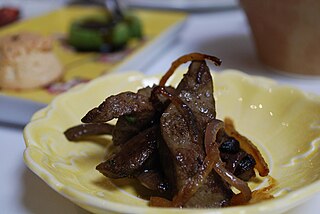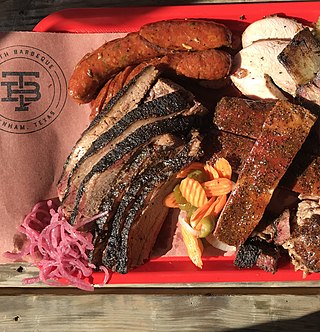
The cuisine of the Southern United States encompasses diverse food traditions of several subregions, including Tidewater, Appalachian, Ozarks, Lowcountry, Cajun, Creole, African American Cuisine and Floribbean cuisine. In recent history, elements of Southern cuisine have spread to other parts of the United States, influencing other types of American cuisine.

Goulash is a soup or stew of meat and vegetables seasoned with paprika and other spices. Originating in Hungary, goulash is a common meal predominantly eaten in Central Europe but also in other parts of Europe. It is one of the national dishes of Hungary and a symbol of the country.

A fried egg is a cooked dish made from one or more eggs which are removed from their shells and placed into a frying pan and fried. They are traditionally eaten for breakfast in many countries but may also be served at other times of the day.

Offal, also called variety meats, pluck or organ meats, is the internal organs of a butchered animal. The word does not refer to a particular list of edible organs, and these lists of organs vary with culture and region, but usually exclude skeletal muscle. Offal may also refer to the by-products of milled grains, such as corn or wheat.

Fried rice is a dish of cooked rice that has been stir-fried in a wok or a frying pan and is usually mixed with other ingredients such as eggs, vegetables, seafood, or meat. It is often eaten by itself or as an accompaniment to another dish. Fried rice is a popular component of East Asian, Southeast Asian and certain South Asian cuisines, as well as a staple national dish of Indonesia. As a homemade dish, fried rice is typically made with ingredients left over from other dishes, leading to countless variations. Fried rice first developed during the Sui Dynasty in China.

Gulyásleves, is a Hungarian soup, made of beef, vegetables, ground paprika and other spices. It originates from a dish cooked by the cattlemen, who tended their herds in the Great Hungarian Plain. These Hungarian cowboys often camped out with their cattle days away from populated areas, so they had to make their food from ingredients they could carry with themselves, and this food had to be cooked in the one available portable cauldron over an open fire.

The cuisine of the Southwestern United States is food styled after the rustic cooking of the Southwestern United States. It comprises a fusion of recipes for things that might have been eaten by Spanish colonial settlers, cowboys, Native Americans, and Mexicans throughout the post-Columbian era; there is, however, a great diversity in this kind of cuisine throughout the Southwestern states.

Lamb fries are lamb testicles used as food. Historically they were parboiled, cut in half, and seasoned. Lamb testicles are served in a variety of cuisines, including Italian, Basque, breaded and fried in some barbecue restaurants, Chinese, Caucasian, Persian and Iranian Armenian, and Turkish. The dish is rarely served at restaurants in the United States, but can occasionally be found at Iranian restaurants.

The testicles of calves, lambs, roosters, turkeys, and other animals are eaten in many parts of the world, often under euphemistic culinary names. Testicles are a by-product of the castration of young animals raised for meat, so they were originally a late-spring seasonal specialty, though nowadays they are generally frozen and available year-round.
Culinary names, menu names, or kitchen names are names of foods used in the preparation or selling of food, as opposed to their names in agriculture or in scientific nomenclature. The menu name may even be different from the kitchen name. For example, from the 19th until the mid-20th century, many restaurant menus were written in French and not in the local language.

Chilean cuisine stems mainly from the combination of traditional Spanish cuisine, Chilean Mapuche culture and local ingredients, with later important influences from other European cuisines, particularly from Germany, the United Kingdom and France. The food tradition and recipes in Chile are notable for the variety of flavours and ingredients, with the country's diverse geography and climate hosting a wide range of agricultural produce, fruits and vegetables. The long coastline and the peoples' relationship with the Pacific Ocean add an immense array of seafood to Chilean cuisine, with the country's waters home to unique species of fish, molluscs, crustaceans and algae, thanks to the oxygen-rich water carried in by the Humboldt Current. Chile is also one of the world's largest producers of wine and many Chilean recipes are enhanced and accompanied by local wines. The confection dulce de leche was invented in Chile and is one of the country's most notable contributions to world cuisine.

Elastration is a bloodless method of male castration and docking commonly used for livestock. Elastration is simply banding the body part until it drops off. This method is favored for its simplicity, low cost, and minimal training requirements.

The Western United States has its cuisine, distinct in various ways from that of the rest of the country. States west of Texas, Kansas, Missouri, and Nebraska would be considered part of this area, as would, in some cases, western parts of adjoining states.

A testicle festival is an event held at several small towns where the featured activity is the consumption of animal testicles, usually battered and fried.

Lamb's fry is lamb offal served as food, including the testicles, liver, sweetbreads, heart, kidneys, and sometimes the brain and abdominal fat—or some combination thereof.

Rocky Mountain cuisine is a cuisine of Alberta and British Columbia in Canada; Idaho, Colorado, Wyoming, Utah and Montana in the United States. Some distinguishing dishes include bison and Rocky Mountain oysters, or prairie oysters as they are known in Canada.

Texan cuisine is the food associated with the Southern U.S. state of Texas, including its native Southwestern cuisine influenced Tex-Mex foods. Texas is a large state, and its cuisine has been influenced by a wide range of cultures, including Tejano/Mexican, Native American, Creole/Cajun, African-American, German, Czech, Southern and other European American groups.

A steak is a thick cut of meat generally sliced across the muscle fibers, sometimes including a bone. It is normally grilled or fried. Steak can be diced, cooked in sauce, such as in steak and kidney pie, or minced and formed into patties, such as hamburgers.

Shredded beef is a preparation of beef that features in dishes from various cuisines. Shredded beef is sometimes prepared using beef brisket and chuck roast. Pot roast is also sometimes shredded.

















